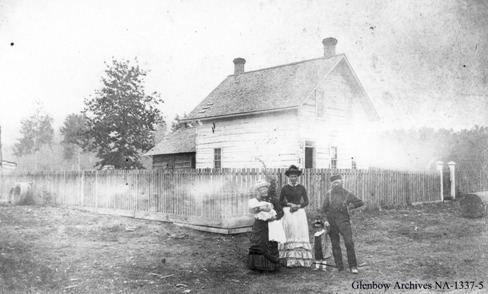Other Name(s)
JOHN WALTER MUSEUM AND HISTORICAL AREA
Walterdale Museum
Links and documents
n/a
Construction Date(s)
1875/01/01 to 1901/01/01
Listed on the Canadian Register:
2005/05/17
 Statement of Significance
Statement of Significance
Description of Historic Place
The John Walter Museum and Historical Area sits on a landscaped park west of the south entrance to the Walterdale Bridge, on the south bank of the North Saskatchewan River. The site is connected to the paths and trails of the Capital City Recreation Park, while the large, modern Kinsmen Fieldhouse stands across a parking lot immediately to the south. The site includes three early dwellings: two rustic cabins built of hewn logs and one substantial Victorian-era residence.
Heritage Value
The John Walter Museum and Historic Area has heritage value for its associations with one of the most important early Edmonton businessmen and community builders. These three dwellings were successively built and occupied by John Walter (1859-1920), the first person to settle on the south bank of the North Saskatchewan River within Edmonton. The three houses as a unit reflect the Walter family's growing prosperity and the different facets of their family life. The first house is a hewn log structure built in 1875, the second, built in 1884, is larger and accommodated his growing family, and the third, built in 1901, exhibits Queen Anne Revival characteristics. Walter built the first cable ferry west of Winnipeg to connect the north and south sides of the river, and started Edmonton's first industry here as a boat and cutter builder. He then established Edmonton's largest sawmill, and became known as Edmonton's 'First Millionaire' before losing his fortune to the great flood of 1915, which destroyed his mills and facilities. His wife, Annie Newby, continued to live in the third house until her death in 1942 and made a distinctive mark on its appearance.
Furthermore, the John Walter Museum and Historic Area provides rich evidence of the evolution of building techniques during the earliest years of Edmonton's history, from the most rustic of shelters to more refined and genteel accommodation. The log structures were built with readily available materials, worked on site with little refinement, a reflection of the rough frontier conditions and isolation of the settlement. The 1901 house demonstrates the rapid evolution of the local construction industry and the new availability of manufactured building materials. Milled lumber and lathe-turned decorative components demonstrate a sophisticated and progressive attitude, and illustrate the rapid maturation of the settlement. These buildings provide valuable physical information about the history of local construction.
Source: City of Edmonton Planning and Development (Bylaw: 13463)
Character-Defining Elements
Key elements that define the heritage character of the John Walter Museum and Historic Area include:
- its highly visible assembly of three early dwellings;
- the 1875 house constructed of rough hewn logs laid horizontally with corner dovetail joints and chinking between the logs, A-framed roof with horizontal ties, simple flat board trim around windows and door, 12-paned wooden sash windows and internal red brick chimney;
- the 1884 house constructed of rough hewn logs laid horizontally with corner dovetail joints with chinking between the logs, A-framed roof with horizontal ties, simple flat board trim around windows and door, fir for the first floor, double-hung 4-over-4 wooden sash windows, internal red brick chimneys at both ends and a door on east side with transom;
- the 1901 house constructed with cross-gabled roof with double-height bay window on the north facade, double assembly double-hung 1-over-1 wooden sash windows in the second floor bay flanked by double-hung 1-over-1 wooden sash windows, large ground floor window with stained glass detailing in the upper portion, double-hung 1-over-1 wooden sash windows, wood drop siding with cornerboards, flat wooden trim with modest crowning detail around doors and windows, stained glass casement window under the eaves above the open half-width front verandah, rear covered porch with gabled roof, decorative spindle work and bargeboards, elaborate pierced gable screens, tongue-and-groove soffits, diagonally set front door opening onto the front verandah, a wood shingle roof, exposed brick foundation and two red brick internal chimneys with corbelling detail.
 Recognition
Recognition
Jurisdiction
Alberta
Recognition Authority
Local Governments (AB)
Recognition Statute
Historical Resources Act
Recognition Type
Municipal Historic Resource
Recognition Date
2005/01/01
 Historical Information
Historical Information
Significant Date(s)
n/a
Theme - Category and Type
- Peopling the Land
- Settlement
Function - Category and Type
Current
- Leisure
- Historic or Interpretive Site
Historic
- Residence
- Single Dwelling
Architect / Designer
n/a
Builder
n/a
 Additional Information
Additional Information
Location of Supporting Documentation
City of Edmonton, Planning and Development Department, 10250 - 101 Street, Edmonton, AB T5J 3P4 (File: 33567428-002)
Cross-Reference to Collection
Fed/Prov/Terr Identifier
4664-0135
Status
Published
Related Places

JOHN WALTER HISTORIC AREA
The John Walter Historic Area comprises three residences situated on roughly 46 hectares of land on the south side of the North Saskatchewan River in Edmonton's River Valley…